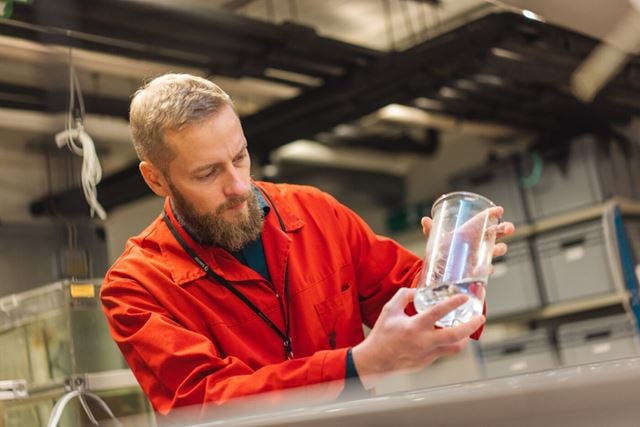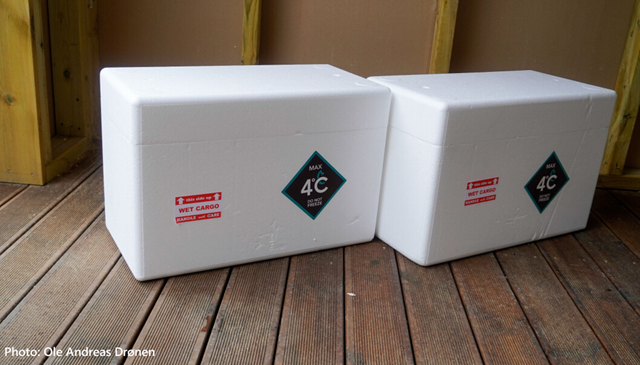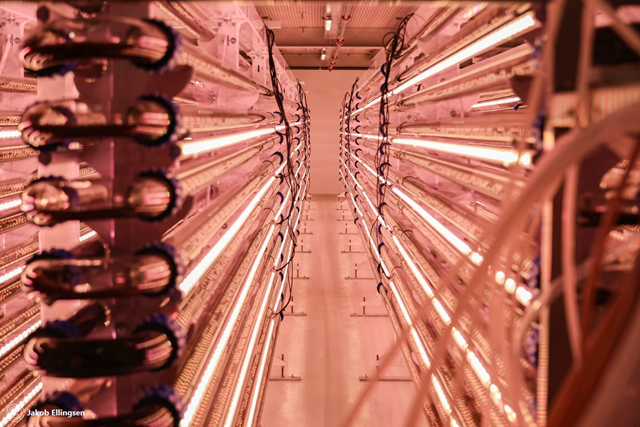A prerequisite for commercial farming of marine fish species is the ability to produce high quality fry. Copepods, assigned to the class Copepoda, have proven to be the perfect starter feed for species such as cod, tuna and halibut. But not enough is currently being produced to meet the demand.
Salmon can be fed dry food immediately after hatching, but marine fish larvae require live feed to grow. And this has to be small enough for the fish fry to eat it.
“Using copepods as feed for marine fry is very popular. The demand and market need for this ‘superfood’ is enormous,” says SINTEF researcher Andreas Hagemann, who is working to develop new biomarine resources.

Andreas Hagemann in SINTEF’s laboratory at Brattørkaia in Trondheim. The photo was taken as part of a different project. Photo: Smidesalng and Lyng
Research has shown that marine fry fed copepods have better growth, survival and quality than the most common feed alternatives.
Recent experiments indicate that the problem of demand exceeding supply can be solved.
“The work we’ve done suggests that we can get copepods to produce significantly more eggs by finding the right breeding stock and caring for them smartly,” says Hagemann.
World’s largest production facility opened
SINTEF has been researching copepods since 2002. In 2014, this resulted in the establishment of the spinoff company CFEED, which produces the nutritious Acartia tonsa species. The company was the first to start land-based production of copepods as feed for marine fry.
CFEED recently opened the world’s largest production facility for copepods. The goal is to be able to deliver much more of the popular – and environmentally friendly – feed.

Today, CFEED sends copepod eggs around the world, where they are hatched and served alive to more than 15 fish species. Photo: CFEED
“If we get females that lay more eggs and at the same time utilize the feed better, we will be able to have much more efficient production,” confirms Tore Remman, CFEED CEO.
Increased capacity means that CFEED will reach more markets. This is good news for more sustainable fish farming.
Larger and hardier
The rotifers and Artemia species have been the most commonly used feeds, but these have poor nutritional value and therefore need to be enriched before use. The copepods, on the other hand, have the perfect built-in nutritional content for marine fish larvae,” says Hagemann.
“In addition, feed utilization is better and the fish become more robust. This also makes copepods a more sustainable alternative,” adds Remman.
Since its inception, CFEED has collaborated closely with SINTEF. Together, they have researched biological challenges, technology, monitoring tools and optimization of production in Vanvikan in the Trondheimsfjord.

Breeding copepods can increase production. The small creature is in high demand and an environmentally friendly superfood for fry. Photo shows the production at CFEED in Vanvikan. Photo: CFEED
The latest research project in the series to date is called SELCOP and is a collaboration between SINTEF, CFEED and Nofima, a world leader in applied breeding and genetics.
From 22 to 96 eggs
The starting point for the project was a theory: The researchers surmised that there is a large individual variation in how many eggs a copepod is able to produce.
“So we were quite excited – and nervous – since no one had tried to breed this species before, says Hagemann.
“We quickly found that this was true. Our experiments showed that the copepods at CFEED produced an average of 22 eggs per day to begin with, but we still found a female that laid up to 96 eggs in the same time frame,” says Hagemann.
30 copepod generations a year
Copepods have a generation time of 10 to 14 days, or about 30 generations a year. Thus, in theory, targeted breeding can have a very large effect within a short time.
“So we were quite excited – and nervous – since no one had tried to breed this species before, says Hagemann.
The researchers started the experiment in the lab with 500 females randomly selected from CFEED’s production facility. They then monitored the egg production and selected the individuals that had laid the most eggs to produce the next generation.
- You might also like reading about the new and exciting species of bristle worm, which is now taking over the salmon industry as a feed resource.
Small, fragile animals
At about 1.5 millimetres, the copepods are tiny and quite fragile. Therefore, the researchers were excited to observe how the copepods would cope and how easy they would be to follow through the breeding programme. The copepods required daily handling for a fairly long time.
“At about 1.5 millimetres, the copepods are tiny and quite fragile.
Synne Spjelkavik smiles. “It was meticulous work, but it was doable,” she says. Spjelkavik works at SINTEF and was responsible for the lab experiments.
The researchers conducted five rounds of breeding in the study. After the first round, they selected the group of females that produced the most eggs.

Tiny, nutritious copepods seen under the microscope. Photo courtesy of CFEED
“After just one generation of selective breeding, production increased on average from 22 to 28 eggs, which corresponds to a 30 percent increase in egg production. The third generation had the best results, with the females producing an average of 36 eggs, a 67 percent increase compared to the starting point,” says Spjelkavik.
Selecting the most productive stock to breed
Generations four and five had small declines.
“We’re a little unsure about what is causing the declines, but it’s possible that we reached maximum potential with generation three. In any case, there is no doubt that breeding copepods will have a significant effect,“ says Hagemann. We just need to learn more to understand how robustly this can be recreated.”
The eggs from the most productive females in generation five are now at CFEED, where the researchers are conducting further tests in their production facility. The goal is to see what the effects are in an industrial setting.
“In this phase we’ll also analyse the DNA to see if the selected line undergoes any genetic changes,” says Hagemann.
The work is funded by RFF Trøndelag (Regional Research Fund Trøndelag) and The Research Council of Norway.
You can read more about the research projects SEQOP and SELCOP.


